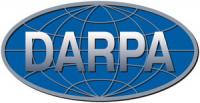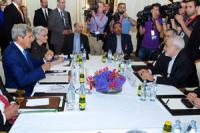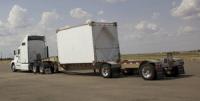-
Iranian enriched uranium limit breached, IAEA confirms
The International Atomic Energy Agency (IAEA) confirmed Monday that Iran has surpassed the stockpile of low-enriched uranium allowed under the 2015 nuclear accord with world powers, known as the Joint Comprehensive Plan of Action (JCPOA).
-
-
U.S. faces long-standing biological threats challenges
GAO officials testified before a House committee on their efforts to identify and strengthen U.S. biodefense. GAO has also released a report highlighting the agency’s findings. Despite President Trump signing off on the Pandemic and All-Hazards Preparedness and Advancing Innovations Act (PAHPA) on Monday, GAO says that there is still a lot of work to be done.
-
-
Rectifying a wrong nuclear fuel decision
In the old days, new members of Congress knew they had much to learn. They would defer to veteran lawmakers before sponsoring legislation. But in the Twitter era, the newly elected are instant experts. That is how Washington on 12 June witnessed the remarkable phenomenon of freshman Rep. Elaine Luria (D-Norfolk), successfully spearheading an amendment that may help Islamist radicals get nuclear weapons. The issue is whether the U.S. Navy should explore modifying the reactor fuel in its nuclear-powered vessels — as France already has done — to reduce the risk of nuclear material falling into the hands of terrorists such as al-Qaida or rogue states such as Iran. Luria says no. Alan J. Kuperman writes in the Pilot Online that more seasoned legislators have started to rectify the situation by passing a spending bill on 19 June that includes the funding for naval fuel research. They will have the chance to fully reverse Luria in July on the House floor by restoring the authorization. Doing so would not only promote U.S. national security but teach an important lesson that enthusiasm is no substitute for experience.
-
-
Shoe scanner may improve airport security
The types of shoes you wear when flying matter. And not just shoe types. Size, material, soles and heels are also very important. Why? Shoes can become dangerous vehicles for terrorists’ plots. DHS wants to prevent future incidents, and this is why S&T is working on a millimeter wave technology for screening shoes as part of the larger Screening at Speed Program.
-
-
New technology to measures WMD threat exposures
Researchers are looking to find molecular signatures in blood that identify previous exposures and time of exposure to materials that could be associated with weapons of mass destruction (including infectious agents, chemicals, and radiation). The epigenome is biology’s record keeper, and Epigenetic technology will provide a new tool in the fight against the proliferation of weapons of mass destruction.
-
-
It’s Alive! Creating innovative “living” bridge
Engineers have designed a unique living laboratory on a heavily traveled iconic bridge which could change the way infrastructure is viewed. The Memorial Bridge, which links Portsmouth, New Hampshire to Kittery, Maine, has been outfitted with data sensors that have transformed it into a self-diagnosing, self-reporting “smart” bridge that captures a range of information from the health of the span to the environment around it.
-
-
Finding and fixing natural gas leaks quickly, economically
From production to consumption, natural gas leaks claim lives, damage the climate and waste money. Researchers are working on better ways to find and fix gas leaks quickly and inexpensively from one end of the system to the other.
-
-
Sensors may not make infrastructure safer
Simply driving down the road gives you a sense for the current state of our infrastructure: crumbling and in need of repair. New technology like sensors offers a way for inspectors to peer inside the systems almost continuously. But just placing a sensor on the side of a bridge doesn’t automatically lead to cost savings and a safer bridge.
-
-
DARPA tests advanced chemical sensors

DARPA’s SIGMA program, which began in 2014, has demonstrated a city-scale capability for detecting radiological and nuclear threats that is now being operationally deployed. DARPA is building off this work with the SIGMA+ initiative that is focused on providing city- to region-scale detection capabilities across the full chemical, biological, radiological, nuclear, and explosive threat space.
-
-
Public dread of nuclear power sets limits on its use
Nuclear power has been a part of the American energy portfolio since the 1950s, but for a number of reasons, the general public has long felt a significant dread about it.
-
-
Iran suspending some nuclear deal commitments

Iranian President Hassan Rouhani announced Wednesday his country will suspend its compliance with prohibitions on stockpiles of enriched uranium and heavy water that were imposed as part of the 2015 international agreement on its nuclear program.
-
-
Examining the safety of using dispersants in oil spill clean ups
A new study of the Deepwater Horizon oil spill recovery efforts makes a series of recommendations to federal agencies on how to safely clean up after spills.
-
-
HBO’s “Chernobyl” exposes the horrifying scope of Soviet deception
The new five-part miniseries, premiering 6 May, examines the Chernobyl nuclear disaster—and the brave people who sacrificed their lives to reveal the shocking truth. The Chernobyl nuclear disaster was the screw-up to end all screw-ups, playing a part in more than 93,000 deaths and turning the northern Ukrainian region uninhabitable. Nick Schager writes in the Daily Beast that, as HBO’s Chernobyl reveals, even more deadly than the radiation released by the accident were the lies that caused it in the first place—and, afterwards, stymied efforts to contain and combat it.
-
-
New sensors can sense and sort troublesome gases
From astronauts and submariners to miners and rescue workers, people who operate in small, enclosed spaces need good air quality to work safely and effectively. Newly developed electronic sensors can simultaneously detect at least three critical parameters that are important to monitor to ensure human comfort and safety.
-
-
Los Alamos nuclear waste successfully shipped to WIPP

The first shipment in five years of Transuranic (TRU) waste from the Los Alamos National Laboratory has been successfully delivered to the Waste Isolation Pilot Plant (WIPP) near Carlsbad, New Mexico.
-
More headlines
The long view
Keeping the Lights on with Nuclear Waste: Radiochemistry Transforms Nuclear Waste into Strategic Materials
How UNLV radiochemistry is pioneering the future of energy in the Southwest by salvaging strategic materials from nuclear dumps –and making it safe.
Model Predicts Long-Term Effects of Nuclear Waste on Underground Disposal Systems
The simulations matched results from an underground lab experiment in Switzerland, suggesting modeling could be used to validate the safety of nuclear disposal sites.
